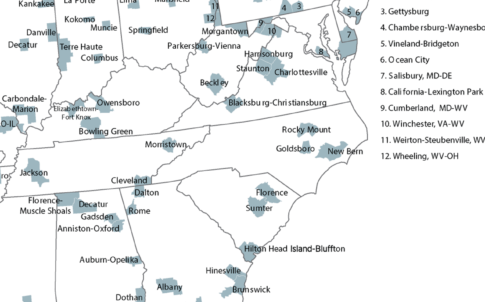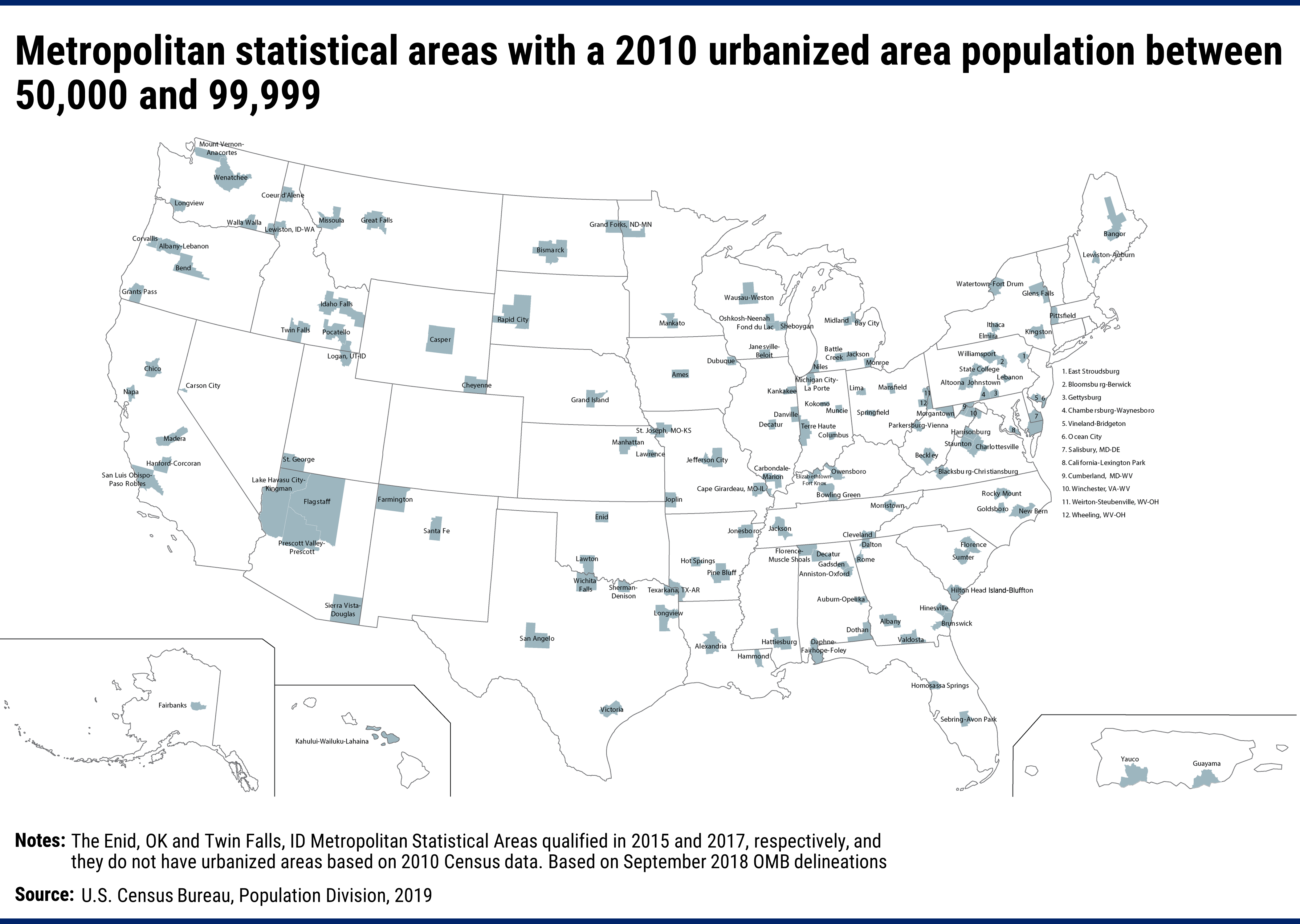Proposed standards impact who is urban in NC

Two recently published Federal Register Notices address how urban areas will be identified after the 2020 Census data are released and how metropolitan areas will be defined. In this post, we detail what the recommendations are, and how that will impact communities in North Carolina.
What changes are proposed and what it means: The key recommendation shifts the minimum urban area population for the core of a metropolitan area from 50,000 to 100,000. In North Carolina, there are three current metropolitan areas that would be classified as micropolitan under this shift: Goldsboro, New Bern, and Rocky Mount. The Daily Yonder has an extended overview on the potential implications of this change.
Want to send feedback? Comments are due by Friday, March 19, 2021.

Federal Register Notice: Urban Areas for the 2020 Census – Proposed Criteria
What changes are proposed and what it means: This proposal has two key proposed changes:
1. It proposes using housing unit density (385 housing units per square mile) instead of population density as the primary criteria for including blocks in urban areas.
Why this is necessary: The use of new formal privacy techniques that will be implemented in the 2020 Census to help ensure responses are confidential require the Bureau to use housing units instead of population count at the block level.
What does it mean: This change will increase the likelihood that vacation destinations with high housing unit density but potentially smaller population will be classified as urban and will better reflect the built environment.
2. The urban definition will change from 2,500 people to 4,000 housing units OR 10,000 people.
What does it mean: In North Carolina, there are 55 communities that were classified as urban areas in 2010 that may not be identified as urban under the 2020 definition.
Want to send feedback? Comments are due by May 20, 2021.
| Name | 2010 Population | 2010 Housing Units |
|---|---|---|
| Franklin, NC | 6,781 | 3,709 |
| Holden Beach, NC | 3,136 | 3,422 |
| Siler City, NC | 9,076 | 3,305 |
| Whiteville, NC | 7,446 | 3,258 |
| Elkin, NC | 6,521 | 3,206 |
| Cherryville, NC | 6,340 | 2,873 |
| Lake Norman of Catawba, NC | 5,603 | 2,744 |
| Wadesboro, NC | 5,791 | 2,674 |
| Williamston, NC | 5,361 | 2,644 |
| Manteo, NC | 5,399 | 2,631 |
| Pembroke, NC | 7,436 | 2,427 |
| Edenton, NC | 4,790 | 2,389 |
| Mount Olive, NC | 5,196 | 2,380 |
| Mocksville, NC | 5,191 | 2,270 |
| Ahoskie, NC | 4,951 | 2,267 |
| Mayodan, NC | 4,382 | 2,257 |
| Farmville, NC | 4,815 | 2,254 |
| Sneads Ferry, NC | 3,899 | 2,141 |
| Jefferson, NC | 4,129 | 2,072 |
| Wallace, NC | 4,345 | 2,020 |
| Taylorsville, NC | 5,388 | 2,009 |
| Plymouth, NC | 4,265 | 2,003 |
| Boiling Spring Lakes, NC | 4,397 | 1,975 |
| Richlands South, NC | 5,278 | 1,871 |
| St. James, NC | 2,604 | 1,853 |
| Seven Lakes, NC | 3,757 | 1,819 |
| Red Springs, NC | 4,185 | 1,810 |
| Buies Creek, NC | 5,628 | 1,801 |
| Fairfield Harbour, NC | 2,726 | 1,703 |
| Fearrington Village, NC | 2,642 | 1,601 |
| Grifton, NC | 3,688 | 1,588 |
| Elizabethtown, NC | 3,085 | 1,581 |
| Whispering Pines, NC | 3,514 | 1,567 |
| Maiden, NC | 3,572 | 1,561 |
| Pittsboro, NC | 3,410 | 1,551 |
| Benson, NC | 3,107 | 1,520 |
| Louisburg, NC | 3,694 | 1,489 |
| Yadkinville, NC | 3,530 | 1,478 |
| Warsaw, NC | 3,045 | 1,428 |
| Spruce Pine, NC | 4,700 | 1,407 |
| Boiling Springs, NC | 4,549 | 1,401 |
| La Grange, NC | 2,713 | 1,381 |
| St. Pauls, NC | 3,288 | 1,361 |
| Troy, NC | 3,618 | 1,320 |
| Burgaw, NC | 3,456 | 1,258 |
| Ramseur, NC | 2,951 | 1,221 |
| Locust, NC | 2,925 | 1,218 |
| Lillington, NC | 3,316 | 1,197 |
| Enfield, NC | 2,672 | 1,189 |
| Fairmont, NC | 2,507 | 1,179 |
| Windsor, NC | 3,566 | 1,169 |
| Tabor City, NC--SC | 3,828 | 1,166 |
| Biscoe, NC | 2,821 | 1,071 |
| Murfreesboro, NC | 2,786 | 1,059 |
| Landrum, SC--NC | 1,585 | 1,027 |
Need help understanding population change and its impacts on your community or business? Carolina Demography offers demographic research tailored to your needs.
Contact us today for a free initial consultation.
Contact UsCategories: Carolina Demographics

The Center for Women’s Health Research (CWHR) at the University of North Carolina School of Medicine released the 12th edition of our North Carolina Women’s Health Report Card on May 9, 2022. This document is a progress report on the…

Dr. Krista Perreira is a health economist who studies disparities in health, education, and economic well-being. In collaboration with the Urban Institute, she recently co-led a study funded by the Kate B. Reynolds Foundation to study barriers to access to…

Our material helped the NC Local News Lab Fund better understand and then prioritize their funding to better serve existing and future grant recipients in North Carolina. The North Carolina Local News Lab Fund was established in 2017 to strengthen…
Your support is critical to our mission of measuring, understanding, and predicting population change and its impact. Donate to Carolina Demography today.